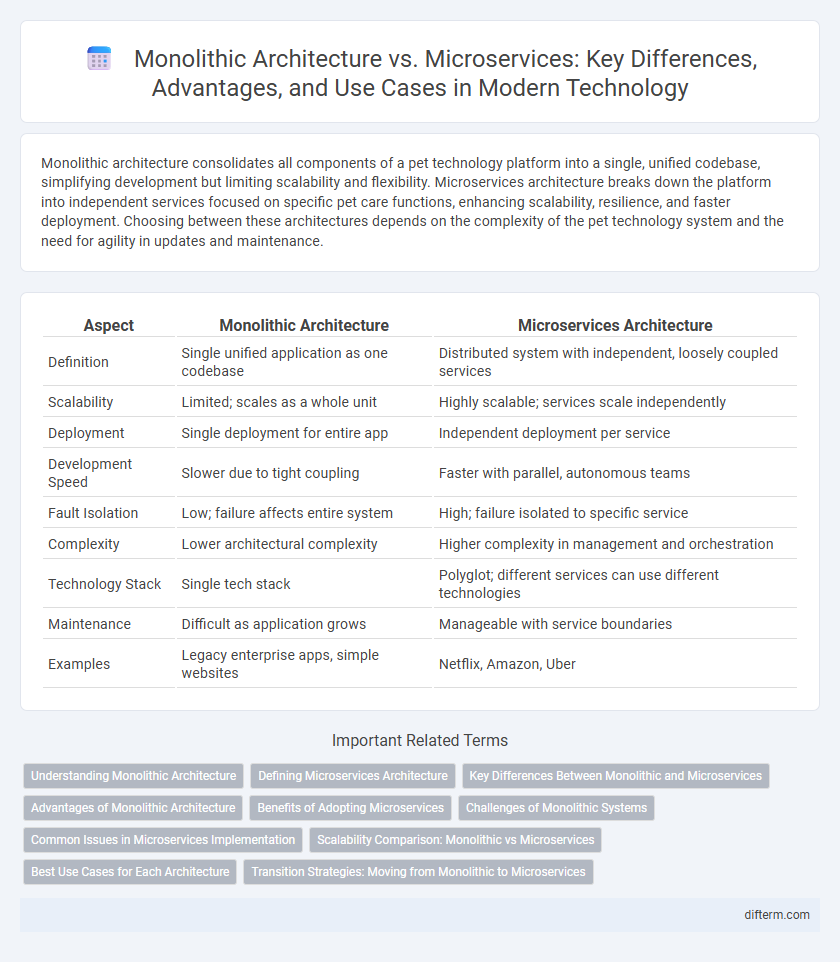Monolithic architecture consolidates all components of a pet technology platform into a single, unified codebase, simplifying development but limiting scalability and flexibility. Microservices architecture breaks down the platform into independent services focused on specific pet care functions, enhancing scalability, resilience, and faster deployment. Choosing between these architectures depends on the complexity of the pet technology system and the need for agility in updates and maintenance.
Table of Comparison
| Aspect | Monolithic Architecture | Microservices Architecture |
|---|---|---|
| Definition | Single unified application as one codebase | Distributed system with independent, loosely coupled services |
| Scalability | Limited; scales as a whole unit | Highly scalable; services scale independently |
| Deployment | Single deployment for entire app | Independent deployment per service |
| Development Speed | Slower due to tight coupling | Faster with parallel, autonomous teams |
| Fault Isolation | Low; failure affects entire system | High; failure isolated to specific service |
| Complexity | Lower architectural complexity | Higher complexity in management and orchestration |
| Technology Stack | Single tech stack | Polyglot; different services can use different technologies |
| Maintenance | Difficult as application grows | Manageable with service boundaries |
| Examples | Legacy enterprise apps, simple websites | Netflix, Amazon, Uber |
Understanding Monolithic Architecture
Monolithic architecture is a software design model where all components of an application are integrated into a single, unified codebase and deployed as one unit. This approach simplifies development and testing processes but can lead to scalability challenges and difficulties in implementing continuous delivery. Understanding monolithic architecture is essential for evaluating its impact on system maintainability, deployment speed, and resource allocation in comparison to microservices.
Defining Microservices Architecture
Microservices architecture is a software design approach where applications are structured as a collection of loosely coupled, independently deployable services, each responsible for a specific business function. Unlike monolithic architecture, microservices enable scalability, flexibility, and faster development cycles by allowing teams to build, test, and deploy components individually. Key technologies supporting microservices include containerization with Docker, orchestration tools like Kubernetes, and API gateways for service communication.
Key Differences Between Monolithic and Microservices
Monolithic architecture consists of a single unified codebase where all components are tightly coupled, whereas microservices architecture breaks down applications into independent, loosely coupled services. Monolithic systems often face scalability challenges and slower deployment cycles, while microservices enable better scalability, continuous delivery, and fault isolation. The choice impacts development speed, maintenance complexity, and resource utilization, with microservices offering granular control and enhanced agility.
Advantages of Monolithic Architecture
Monolithic architecture offers simplicity in development and deployment by consolidating all components into a single codebase, which streamlines testing and debugging processes. It provides better performance due to direct communication between components without network latency, making it ideal for smaller-scale applications. The unified structure reduces operational overhead and facilitates faster development cycles, especially for teams with limited resources.
Benefits of Adopting Microservices
Microservices architecture enhances scalability by allowing independent deployment of services, which reduces downtime and accelerates development cycles. It improves fault isolation, meaning failures in one service do not affect the entire system, thus increasing overall system resilience. This modular design supports continuous integration and delivery, enabling faster innovation and better alignment with agile methodologies.
Challenges of Monolithic Systems
Monolithic architecture often faces challenges such as limited scalability due to tightly coupled components, making it difficult to update or deploy individual features independently. The single codebase increases the risk of system-wide failures and complicates debugging processes, impacting overall reliability. These constraints hinder agility and slow down the development cycle in fast-paced technological environments.
Common Issues in Microservices Implementation
Microservices implementation often faces challenges such as service dependency complexities, data consistency issues, and increased operational overhead. Network latency and fault tolerance become critical concerns due to the distributed nature of microservices. Effective monitoring, automated deployment pipelines, and robust inter-service communication are essential to mitigate these common issues.
Scalability Comparison: Monolithic vs Microservices
Monolithic architecture faces challenges in scalability due to its tightly coupled components, requiring the entire application to be scaled even for small changes. Microservices architecture enhances scalability by allowing individual services to be scaled independently based on demand, optimizing resource usage and performance. Cloud-native environments and container orchestration tools like Kubernetes further accelerate microservices scalability, supporting dynamic workload management and rapid deployment.
Best Use Cases for Each Architecture
Monolithic architecture is best suited for small to medium-sized applications with straightforward business requirements, providing easier development, testing, and deployment due to its unified codebase. Microservices architecture excels in complex, large-scale systems requiring scalability, independent deployment, and technological flexibility, making it ideal for applications with diverse, evolving components or high traffic demands. Organizations with rapid feature development cycles and cross-functional teams benefit most from microservices, while startups and projects with limited resources may prefer monolithic designs for faster time-to-market.
Transition Strategies: Moving from Monolithic to Microservices
Transitioning from monolithic architecture to microservices requires careful planning, including identifying domain boundaries and gradually decomposing the monolith into independent services. Employing techniques like the Strangler Fig pattern allows incremental migration by routing parts of the application to new microservices while keeping the monolith operational. Automated testing, continuous integration, and containerization tools such as Docker and Kubernetes play vital roles in ensuring smooth deployment and scalability of microservices during the transition.
Monolithic Architecture vs Microservices Infographic

 difterm.com
difterm.com